08 Oct -70°F at Noon in Denver, Colorado!
New EnviroChamber hits -70°F in Early Testing
Safety One’s newest addition to our testing and training capabilities is our EnviroChamber. It can produce temperatures of -15F and above 150F. Throw in a 40MPH wind and you have a -70°F Wind Chill Temperature!
Its can allow students from both our snow cat operators, winter survival, tower climbing and rope access divisions to have the benefit of real world testing of their clothing and climbing gear under extreme environments. In addition to temperature fluctuations the EnviroChamber can control wind speeds up to 50 mph as well as humidity levels from 0-100% and can produce icing conditions, clouds and blinding snow. While in these conditions the chamber can record and document the patients physiological responses as well as the effectiveness of each layer of clothing for insulating and breathability. Thorough testing of various brands of cold weather gear will commence shortly and we will post the results on Safety One’s blog as we get them.
In the first full day of testing we wanted to test a theory about how a tower climbers hands react to the constant contact with cold metal in the winter. Cold metal robs the body’s heat 17 times faster than exposure to air at the same temperature. We measured temperatures of the subjects core and fingers as well as oxygen saturation of the blood at the finger tips while he was in the EnviroChamber at -5F. As expected we were quickly able to document that the finger tips of cold hands dropped in temperature and oxygen saturation of the blood with minutes of cold exposure. This was due to the body’s response of vasoconstriction (shrinking arteries and veins) in the cold hand (s). Then we made it more interesting to test how much effect the hypothalamus of the brain had in regulating this response to cold (how much affect did the brain have on this response as opposed the just the nerves in the effected hand). To do this we left the same temperature and oxygen saturation sensors in place on the subjects hands and had the climber remove one glove and keep the other gloved hand safely out of the wind and in the armpit of the climber. Nobody was surprised that the hand that was left without a glove immediately showed temperature and oxygen saturation drop in the finger tips (oxygen saturation is key to a climbers hand strength and sensory perception). What was startling was the the gloved hand that was kept out of the cold wind ALSO showed a drop in temperature and oxygen saturation at the finger tips although not as severe as the exposed hand measured at 1,3 and 5 minutes. Obviously the vasoconstriction that results from cold exposure is controlled to some degree by the hypothalamus (temperature regulating area of the brain) or the non-exposed hand would not have showed any changes. Thus a climber which has one cold hand and intends to use the other warmer protected hand for performing strenuous or sensitive work is going to suffer the same drop in capabilities with the hand he kept warm. Simple take away, both hands must be kept warm if the climber is to perform his tasks safely! We will be testing a wide variety of gloves in Safety One’s EnviroChamber in the near future and will let you know the results.
A tower climber or rope access technician relies on his hand strength and ability to perceive touch to perform his work safely. This first crude test shows an interesting phenomenon we will be exploring with future research in Safety One’s EnviroChamber. We will keep you up to date on the blog!
Stay Warm – Winter is Coming!
Art Seely
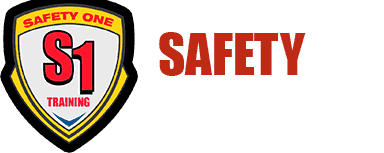
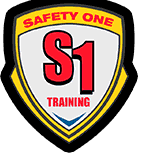
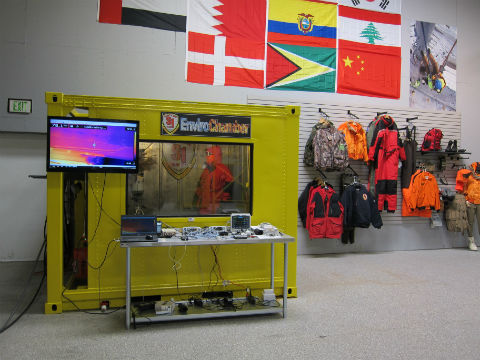
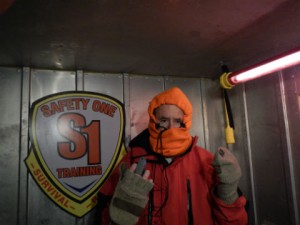
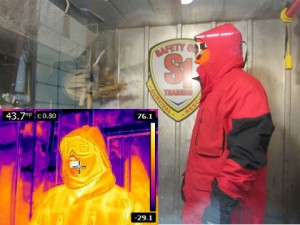
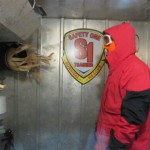
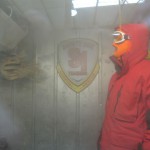
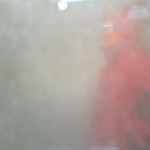
Keith Genter
Posted at 13:18h, 27 OctoberI live in the Interior of Alaska. We see temperatures ranging from around 90F during the summer, to -60F during the winter, not including the wind chill factor. I find it interesting that a small chamber was built to replicate the conditions that we live in for most of the winter. I’m glad the research is being conducted and lessons learned will come from it all. Good luck and I look forward to your continuing efforts, Keith
Dan Zillich
Posted at 07:20h, 21 OctoberGreat addition to your already great training programs, I cant wait to read more about the results of your tests in the new chamber.